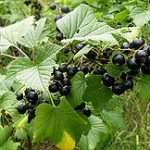Blackcurrants and time off work
There are still two jars of blackcurrant jam and a jar of coarse marmalade. The round of church fêtes and sales brings with it an accumulation of countless buns, cakes and preserves. It would not be proper to pass by a stall of home made produce, (one sale before Christmas required a walk to the cash till in order to replenish the funds and make sure no-one’s efforts were overlooked).
The blackcurrant jam is as near perfection as blackcurrant jam might be, the fruit fresh and flavoursome. Its scent and taste evoking moments from the 1970s.
It must have been 1971, for transistor radios were constantly filled with the sound of ‘Chirpy, Chirpy, Cheep, Cheep’. My dad had a week’s holiday and we spent time picking blackcurrants at a fruit farm which paid pickers so many pence for each pound of currants they brought to the farm buildings, the buckets being placed on scales and then the fruit being tipped into bigger containers. There were lots of people there; there was not much money around in 1971 and the chance to earn something extra was not one to be passed.
Did we pick enough fruit to earn a few pounds? It’s hard to remember. A few currants were eaten, but after a few handfuls the hands and the lips were black and the appetite had worn off.
We spent the other week of my dad’s holiday in a caravan at Lyme Regis. It was our first family holiday and remains an important moment.
It is strange thinking back how few holidays people had. There was Christmas Day and Boxing Day, Good Friday and Easter Monday, Whit Monday and August Bank Holiday – six public holidays a year and perhaps a week or two annual holiday. To spend a week blackcurrant picking would seem odd now, but working for part, or all, of the annual holiday was common enough. Irish people living in England would have returned to family farms to assist with saving the hay or gathering in the harvest, returning to England at the end of the holiday might have come as a relief.
Looking back on such times, there is a sense of how much time people have now. The working week was often five and a half or six days and working an eight hour day might mean starting at 7.45 am and finishing at 5 pm, the tea break and lunch hour being in your own time.
A recent report in England complained at the cost of public holidays. Anyone who looks at the history of industrial relations in the 1970s will see the cost of extra holidays is far outweighed by having a workforce considerably happier than their counterparts forty years ago. To have had four or five weeks annual holiday then, as well as extra bank holidays, would have left you feeling like a millionaire – and have provided many more opportunities for picking blackcurrants.



In Worcestershire it was pea picking and hop picking that were communal events.
I wonder what the hourly rate of pay worked out at. There were women in our village who used to stitch leather gloves at home; I think the hourly rate was tiny.
Ian, do you remember the Gypsy children who used to attend Ham school once a year whilst their parents picked peas for Harry Inder ? I wonder what their hourly rate was? It probably involved some cider!
I do remember them. They used to arrive around September time and move on a few weeks later. I’ve often wondered where they spent the winter. It must have been a hard old life.
Well as it happens I am currently reading a book I picked up ‘cut price’ in a local garden centre (one of those that sells everything!) Titled ‘Dreams of the Road’ (Gypsy life in the West Country) by Martin Levinson and Avril Silk and it’s quite interesting how they survived and their way of life..There is even a small picture of the pea pickers at High Ham in the 1950’s. If you are interested there are 2 ISBN no’s 13:978 1 84158 505 5 and 10: 1 84158 505 X publishers .. http://www.birlinn.co.uk
We would be out in season every year picking blackberries from the roadside brambles – and stealing fruit from each others buckets and bags to add to our own.